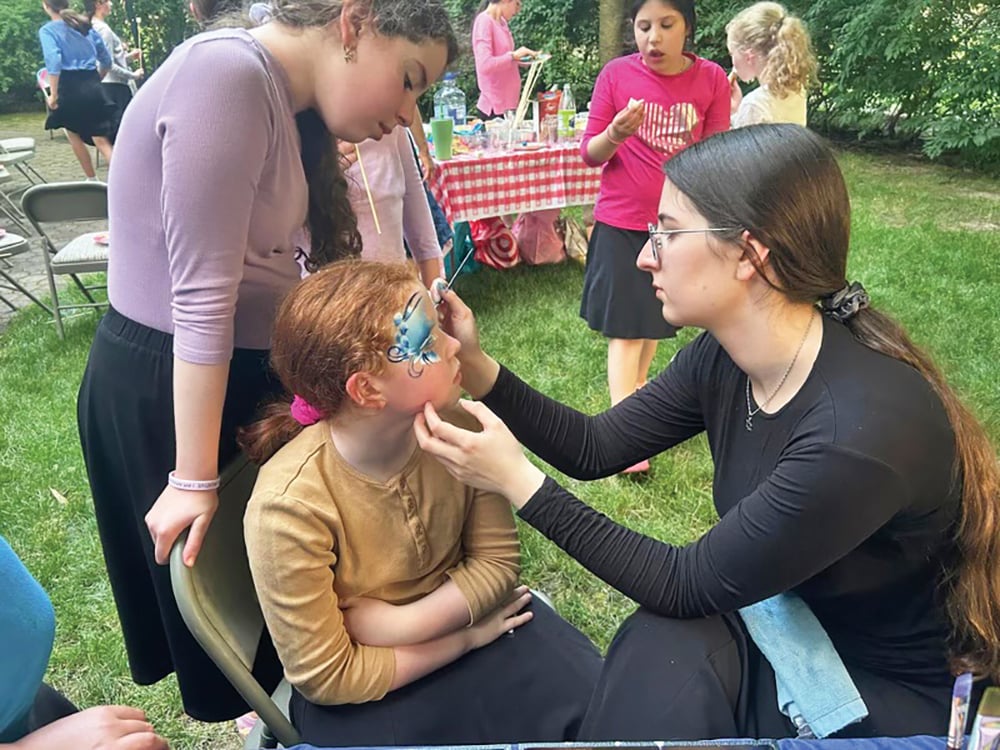As Jews, we love to complain about food. Just go to any shul kiddush, or Jewish wedding or Facebook post on Great Kosher Restaurants Foodies. This is a long Jewish tradition. We have been complaining about food for generations. It’s something we have done since our time as wandering Jews in the desert. The Jews in the desert complained a lot, especially about the food.
This essay will posit that the complaint about the food was merely a subtext for their true complaint about the nature of freedom and enslavement, a very important message when so many of us feel enslaved to our personal devices in this technological world.
While reviewing the Torah portion this past week, Parshat Behaalotcha, I was drawn to one notable episode. The children of Israel complained to Moshe about the manna that they eat every day, which can taste like anything. It’s the perfect food and yet they complained, saying that they missed the fish they ate in Egypt for free, and the cucumbers, and the watermelon, and the leeks, and the onions and the garlic. The children of Israel preferred the free food of Egypt to manna from heaven, which they felt came with a need to show total devotion to God.
What were they complaining about? They complained about the fish that they ate when they were slaves in Egypt. Rashi questioned why their Egyptian taskmasters would give them this fish for free. He noted that the Egyptians, when they enslaved the Israelites, didn’t even give them the straw for free so why would they give them the fish. He answered that the Jewish complaint really isn’t about fish they ate in Egypt. It’s a complaint about the fact that when they were in Egypt, they were free from the yoke of the commandments. They were free from limits, the obligations that they were given at Har Sinai and they wanted to go back to that freedom.
All the commentators question Rashi, since in reality the Egyptians did give the Hebrews the straw for free. Only toward the end of their enslavement, after Moshe came to Pharaoh and said, “Let my people go!” does Pharaoh respond saying the people are lazy and that’s why they wanted to go free. And as a punishment, he decided to take away the straw they needed to produce their quota of bricks. So in reality, the Egyptians did give the Israelites free straw during their enslavement in Egypt.
Nechama Liebowitz quotes Rabbi Anselm Solomon Astruc, in Midreshei Torah, who pointed out the obvious. Why were the Israelites given fish for free in Egypt? Not out of the benevolence of the Egyptians, but out of the selfish desires of the Egyptians for them to work harder. Just like the straw, which they were given to create the bricks, the food they were given was so they would work with greater strength to do the backbreaking labor. They were only given this “free” food because it had a price on it. There’s no such thing as a free lunch or, as we commonly say today, if you are not paying for the product then you are the product.
The Israelites in Egypt were given their food for free because they were the product. They were the labor to create the bricks, to create the storehouses. They were given the food to facilitate their work. Similarly, when we are given technology products for free today, it is because we are not the customer, but the product.
When we look around our technological world, many of us use free products on a regular basis that we think were given to us out of the benevolence of companies. Right now, I’m writing this article for The Jewish Link using Google Docs, which is free. And I’m going to later email this article to the editors using Gmail, which I get for free as well. Why does Google, one of the five most valuable companies in the world, give away so many of its products for free? Because we are not the customers, we are the product. We make a trade with Google. We are giving away our data, what we write in our Docs and what we send in our email, so Google can then use that to better target advertising, as Google is by far the most valuable advertising company in the world.
Their searches and their Gmail and their Docs are really just to show ads. And we are willfully giving away our data. Now, this might be a trade we are willing to make, and it might actually be for the betterment of society, that we can get products for free in exchange for the advertising. This very newspaper is a free newspaper because of the ads which pay for the paper. Many of these ads we enjoy. I have found many businesses through their ads in The Link. It’s not necessarily a bad thing. You just have to realize that it is a thing.
I remember back to my time when I was a kid when I spent many hours watching free television, watching reruns of “Gilligan’s Island” and “The Brady Bunch” over and over again. And why was I being given this product for free? Because in exchange, I was watching commercials for cereal brands, for snack foods and for toys. The advertisers paid a lot of money for me to watch this so that I could have the privilege of watching “Gilligan’s Island “and “The Brady Bunch,” and later on, watching “Friends” and “Seinfeld” in exchange for the advertising dollars. This is not necessarily something to be worried about, but it is something to realize.
This is the issue to recognize when we talk about social media and its potential harms to us and our children. The products of Instagram and Facebook and TikTok are also given to us for free. Similar to Gmail and Google Docs, the incentive of the companies is for you to use social media as much as possible. And the way to get you to use it is to make you virtually addicted to these social media platforms.
Social media, unlike productivity tools to send letters or write documents, is really about entertainment, but entertainment that you willfully give them by providing the pictures and the videos. This is not like the passive watching of TV in the past. It’s an active experience and one that unfortunately we have seen recently can have a serious detriment to the mental health of many, especially our children who are on social media as well, as we see in the writings of Jonathan Haidt. It’s not the innocent “Gilligan’s Island” and “The Brady Bunch” of yesteryear because the experience of social media is much more addictive and much more of an immersive experience. They make money out of the more eyeballs and the more time you spend on the product to be able to then target advertising to you.
The social media companies do this in many different ways which are almost unethical, bordering on the immoral. One example is that social media works like a slot machine. Slot machines and other gambling devices draw people in using a number of methods which are mimicked by social media:
- Ludic Loops: Experts describe ludic loops, which are repeated cycles of uncertainty, anticipation and feedback. When you pull the slot machine lever you are uncertain what the result will be. Then the various icons on the slot machine turn as you anticipate how they will fall. And finally, the icons provide feedback with symbols for cherries, oranges, lemons and other fruits, as well as playing card symbols like aces, jacks, kings and queens. Similarly, when you scroll through your social media posts or TikTok videos, you never know what you will be shown next. The social media app pulls you in by giving you a constant rush of uncertainty, anticipation of what post you will see next, and feedback when you then see the post.
- Variable Rewards: When pulling the slot machine lever, you never know what you will get. Often you will just get a random series of icons. However, you will get a streak with its accompanying sounds, flashing lights and coins just often enough to keep you hooked. And these rewards are random so you never know what the next pull of the handle will bring. Similarly, when you post something on social media, it will provide you with just enough likes, comments and notifications to keep you constantly coming back for more.
- Pull and Refresh: Every time you pull the lever of the slot machine, new images appear which makes you constantly want to pull the lever again. Similarly, every time you refresh your social media timeline, new items come up on your feed.
- Infinite Scrolling: You can play the slot machines forever with no indication of a stopping point. Similarly, when you scroll on social media, the scrolling never stops. The feed is designed so there is no beginning and end. This is to suck you into the app for minutes and sometimes even for hours without ever providing a cue that you have “finished” your feed.
This is very different from the media of yesteryear. When you watched an episode of a sitcom, the sitcom episode was 22 minutes long and with commercials it was 30 minutes from beginning to end. Each episode followed a similar story arc, with a teaser before the theme song to introduce the problem. After some commercials, this was followed by subplots throughout the episode revolving around the central confrontation and a resolution of the different subplots, all usually solved in 30 minutes. This was the cue that the program was over and you could either continue with a different episode or get up to stretch, take care of other things or do your homework. But in modern social media, there is no beginning, middle or end. It sucks you in forever.
And one more thing that the social media companies do to make you addicted to their app is through their constant notifications about new items on your social media feed. For example, when you have an Instagram or a Facebook account, it will constantly be pinging your phone with new content that might be of interest to you and people who might be trying to connect to you. This is designed to interrupt whatever else you might be doing and open the app. Imagine if your TV would constantly ping you about your show. Social media does this and unlike the television, which is a physical item sitting in a room, social media is in your pocket on your smartphone at all times.
So what can we do as consumers (or products) of social media and as parents of children who consume social media as well? Here are suggestions that I do myself as well as recommendations that we see coming out of Jewish day schools, who are starting movements to make parents more aware about the harms of social media:
- Screen Time: The simplest thing to do on an iPhone is to monitor screen time. If you don’t know how to find screen time, just pull down on your phone screen to open search, type screen time and press enter. Using the iPhone’s screen time feature, you set app limits to limit your daily screen time on social media platforms. Mine is currently set to one hour a day and then the social media will turn off. I can then turn it back on to stay on longer, but this forces me to be mindful of how much time I’m spending on social media and not endlessly scrolling. Obviously, this only works for adults as teens will rarely set up screen time on their own. However, as a parent, you can set up Family Sharing which lets you set screen time and other features on your child’s devices. See this link for more information: support.apple.com/en-us/108806.
- Downtime: Similar to screen time, you can set downtime so apps will only work during specific times of the day. I do this with other time-wasting activities. For example, I will sometimes binge watch television programs on Netflix or other streaming channels, but I try to only do this in the evening after my workday is done. My friends complain when we discuss the latest TV programs that I often say I watched an episode but fell asleep in the middle. This is because I really only watch episodes of streaming shows after 9 p.m. when my brain is fried, my work for the day is done, and I want to rest.
Similarly, we should try our best to set times for social media use so we are not using it throughout the day, a reason that children, even if they are old enough to use social media, should not be using social media during the school day. Just like we would have limits on our kids for their TV watching until they do their homework and finish their other tasks, we should limit their social media use.
- Notifications: A very important suggestion which I do myself, is to turn off notifications on all social media apps. There is no reason for you to be notified about an Instagram or a Facebook or a TikTok. You don’t need that. Many people want to be notified about their WhatsApp and their text messages and I understand that. But why would you need to be notified about the latest post on Instagram? Turn off the notifications. Make social media something you only access when you choose to, not when you are drawn into the app because the company is notifying you.
- Age Limits: Finally, and most importantly, social media apps have age limits. Right now, the age limit is 13. Back in 1998, when Congress passed the Children’s Online Privacy Protection Act (COPPA) requiring parental consent before collecting personal data from children, the bill was drafted to apply to all children under 16. When the technology companies balked, the age limit was lowered to 13. This wasn’t for any developmental reason. This was purely based on tech companies wanting to suck children into their apps. So certainly, children under 13 should never be allowed to use social media. And as has been written about in this paper, there is a movement among parents in Jewish day schools to agree that all children will not be on social media until after eighth grade. A 14-year-old brain is much more capable to start this process and take these suggestions than a middle schooler who has much less impulse control and can become more easily addicted to these apps with the emotional harm they can cause.
There are many wonderful things you can do on social media; many of us are using it now to keep tabs on Israel, to advocate on behalf of Israel, to advocate for other Jews, share recipes, and swap unwanted stuff cluttering our house to people who could use it. So, I don’t advise banning these apps. There’s a reason that so many people want to use social media. But we need to use it mindfully. The beginning of Parshat Behaalotcha might provide some guidance.
I believe that the response to the Jews who complained that they wanted to go back to the free fish and freedom from God’s commandments that they enjoyed in Egypt actually comes in the first few verses of Behaalotcha. The refuah comes before the maka; the medicine comes before the illness. The Parsha starts with the lighting of the menorah. The word the Torah uses for lighting, is not Hadlaka, it’s Behaalotcha, coming from the word Aliyah, meaning to raise up.
Rashi commented that this is so that we make sure to light the candles in such a way that they can raise up their flame on their own. The Sfas Emes noted that the candle here represented the mitzvot and the Torah is the light. The message is that Hashem gave us 613 mitzvot. Although later the Jews would complain that the mitzvot were a burden that enslaved them, the mitzvot actually free us. They free us from our drives, from all the things that would enslave us. Because even when slaves get freedom, they will remain enslaved to their yetzer, to their various drives, unless together with their freedom they receive a sense of purpose, a higher meaning to their life. That’s why Hashem gave the Torah to the Israelite slaves after they left Egypt. Hashem, in his infinite wisdom, gave us 613 different mitzvot, 613 different ways to free us through the mitzvot.
And what does the Torah say at the beginning of the parsha? It says, “Behaalotcha et Haneirot.” The goal of Judaism is to light the candles until they light on their own, to get involved in mitzvot, to teach others to do mitzvot until we can do them on our own. Similarly, our goal in raising our children in a world of social media is to set limits and guidance to our children’s use so they can gradually learn to be thoughtful technology consumers who can independently and effectively monitor their own use of these powerful yet potentially harmful tools.
If you want to free yourself from the throes of social media addiction, from all the distractions out there that could be mentally not healthy, the answer is to choose one or many of the 613 mitzvot to do. The mitzvot free us to be our true selves and to fight against our drives.
Rabbi Tzvi Pittinsky is the director of educational technology at Yeshivat Frisch. He can be reached at [email protected].










